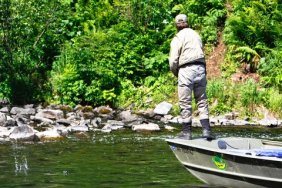 Let’s face it; life happens. My meaning here is that, due to injury or some other physical limitation, not all of us can handle the trails as easily as others, or even as easily as we ourselves once could. There’s no shame in admitting that. The real shame would be being too proud to admit it before it’s too late and you cause yourself further injury. Furthermore, some gear is designed to prevent long-term injury and is not just for those who need a little help. For this reason, trekking poles come into play. Not all trekking poles are created equal, however, and today we’ll take a look at some of the variations you’ll find at your local outdoor retailer.
Let’s face it; life happens. My meaning here is that, due to injury or some other physical limitation, not all of us can handle the trails as easily as others, or even as easily as we ourselves once could. There’s no shame in admitting that. The real shame would be being too proud to admit it before it’s too late and you cause yourself further injury. Furthermore, some gear is designed to prevent long-term injury and is not just for those who need a little help. For this reason, trekking poles come into play. Not all trekking poles are created equal, however, and today we’ll take a look at some of the variations you’ll find at your local outdoor retailer.
Trekking poles have become standard equipment for many hikers, due to their efficiency at helping to maintain balance and stability, especially during ascents and descents. They’re also designed to reduce strain on your legs and joints, as well as aid in stream crossing and navigating slippery terrain, such as ice and snow. As you can see, they’re not just canes or walkers for the trail.
There are a few different types of trekking poles to consider. Standard trekking poles tend to be lighter and somewhat less expensive than some other models. They won’t do as good a job at absorbing shock as other types, but they’ll still provide the same level of stability.
Anti-shock poles feature a special spring mechanism inside the shaft that compresses slightly as weight is applied to the pole. Not only does this reduce shock, but it reduces strain on your wrists, as well. Furthermore, you can usually disable the shock mechanism if you want.
For the diminutive outdoorsman, you’ll find compact trekking poles. Designed for shorter individuals, this variation is lighter, collapsible to a shorter length, and may feature a smaller grip, as well.
Of course, there are always walking sticks and hiking staffs, which are single poles designed for hiking and walking over less treacherous terrain.
As I’ve said, trekking poles are not just for those who may need a little more balance help, but for people who venture into uneven terrain or are carrying a full pack. The extra points of contact greatly increase stability and reduce the risk of long-term injury, which I’m sure we can all agree is a definite bonus. The tips outlined above will help you choose the trekking poles that are right for you so that you’ll be just that much safer on the trails!








